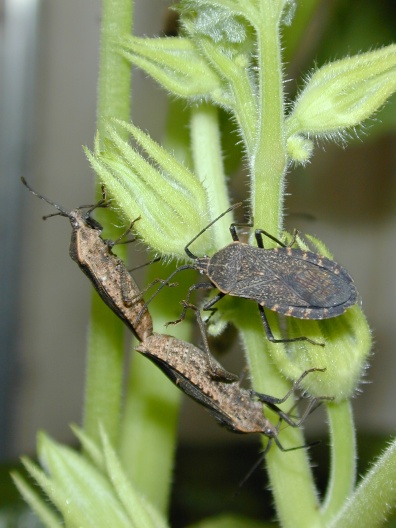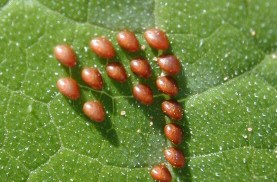Squash Bug
 Scientific Name
Scientific Name
Anasa tristis
Hosts
All cucurbit vine crops are subject to squash bug infestation. The bugs prefer squash, pumpkin, watermelon, cantaloupe, and cucumber, in that order. Hubbard, winter, and marrow squash are often heavily infested.
Symptoms
 Both the nymphs and adults feed by sucking juices from the plants. The overwintered
adults can cause extensive damage as they appear just after the plants have emerged.
Their feeding can greatly stress and even kill young seedlings. Once the plants attain
greater size, they can withstand a moderate number of squash bugs. Nymphs tend to
feed in clusters at first but will disperse as they become older. All stages prefer
the leaves but will feed on all above ground plant parts. They may congregate and
feed on unripe fruits, especially late in the season. Squash bugs can increase in
numbers quite rapidly and can cause plants to wilt just by sheer numbers. When large
numbers are combined with hot, dry weather, the stress on plants is greatly increased.
However, squash bugs will not kill plants "overnight." If plants wilt and die overnight,
one should suspect another causal agent, such as bacterial wilt.
Both the nymphs and adults feed by sucking juices from the plants. The overwintered
adults can cause extensive damage as they appear just after the plants have emerged.
Their feeding can greatly stress and even kill young seedlings. Once the plants attain
greater size, they can withstand a moderate number of squash bugs. Nymphs tend to
feed in clusters at first but will disperse as they become older. All stages prefer
the leaves but will feed on all above ground plant parts. They may congregate and
feed on unripe fruits, especially late in the season. Squash bugs can increase in
numbers quite rapidly and can cause plants to wilt just by sheer numbers. When large
numbers are combined with hot, dry weather, the stress on plants is greatly increased.
However, squash bugs will not kill plants "overnight." If plants wilt and die overnight,
one should suspect another causal agent, such as bacterial wilt.
Life Cycle
 Squash bugs overwinter as unmated adults under plant debris or other suitable shelter.
They emerge in late April or early May, search for suitable hosts, and mate. Eggs
are laid over a period of several weeks, often in the angles formed by leaf veins,
and hatch one to two weeks later. There are five nymphal stages and they take four
to six weeks before new adults are produced. There are three or four generations per
year, but due to the extended egglaying period all stages are present for most of
the season. Nymphs present in late fall are killed by freezing temperatures and adults
seek overwintering quarters.
Squash bugs overwinter as unmated adults under plant debris or other suitable shelter.
They emerge in late April or early May, search for suitable hosts, and mate. Eggs
are laid over a period of several weeks, often in the angles formed by leaf veins,
and hatch one to two weeks later. There are five nymphal stages and they take four
to six weeks before new adults are produced. There are three or four generations per
year, but due to the extended egglaying period all stages are present for most of
the season. Nymphs present in late fall are killed by freezing temperatures and adults
seek overwintering quarters.
Description
 Adults are brownish black to dark ashy black in color and about 5/8 inch long. The
body is compact and flat across the back with the wings overlapping toward the rear.
They give off a disagreeable odor when handled or crushed. Eggs are somewhat diamond
or spindle-shaped and white when first deposited. They gradually turn yellowish brown
and finally dark bronze. They are laid in loose masses, mostly on the undersides of
leaves. Newly hatched nymphs are pale green. As they grow, they develop a grayish
body color with black legs. Nymphs are smaller than adults and do not have wings,
but the last two nymphal stages have noticeable wing pads.
Adults are brownish black to dark ashy black in color and about 5/8 inch long. The
body is compact and flat across the back with the wings overlapping toward the rear.
They give off a disagreeable odor when handled or crushed. Eggs are somewhat diamond
or spindle-shaped and white when first deposited. They gradually turn yellowish brown
and finally dark bronze. They are laid in loose masses, mostly on the undersides of
leaves. Newly hatched nymphs are pale green. As they grow, they develop a grayish
body color with black legs. Nymphs are smaller than adults and do not have wings,
but the last two nymphal stages have noticeable wing pads.
 Control
Control
Please contact your local county extension office for current information.
